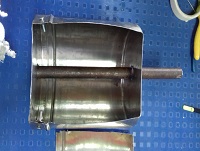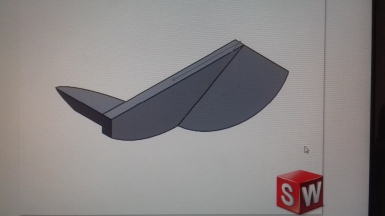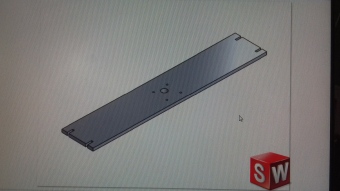FIRST PROTOTYPE FOR ROASTING THE FLOUR :
After meeting of Siddhesh sir with Anil Gosavi sir who suggested design for roaster . Suggested design was horizontal drum which is cut at top in which blades are fitted .
To make sure about design , I started making prototype of this .
1.First cut the 1/3rd portion of a drum by using grinder .
2.Took a metal rod to fix the blade in stirrer and cut it.

3.According to dimension of a drum ,made design of blade in solidworks and cut it on plasma cutter .
4.Fixed the blade in drum .

5.Made a stand for that roaster .
6. Fixed whole assembly of roaster on stand .
Trials on prototype
First trial
At 1st trial I observed that , small layer of flour was not stirred properly and burnt it because it remained at the bottom of drum.It occured because small clearance remained between bottom surface of drum and surface of blade and non uniformity in heat transfer.

Remedies on drawbacks of 1st trial
After that I minimize that clearance by using aluminium foil on blade and for uniform heat transfer I designed horizontal pipe on which small holes were created to .
Second trial
At second trial , used biogas as a source of heat . It transfered through that horizontal pipe .In second trial mass transferred efficiently but heat transferd only at the bottom surface.

Remedies
Dixit sir told us to take a trial on coal as a heat transfer medium .
Third trial
I took third trial in which kandi coal was used for heat distribution and way of mixing was as follows –
1.Added some ghee and then added flour.
2.Added flour and added ghee dropwise .
In first attempt , mixing was not done properly . There was some pieces of flour and ghee was remained .
Problem solved in third trial
1.Heat distribution was done properly .
2.In second attempt , problem of mixing was cleared in some amount .
To get a trial on large amount , I decided to make a large drum for roasting and automation in it . for that I removed the motor from composter. After that I drawn a design for blade in solidworks. Cut the square rod by using grinder in 45 degree angle .To make a stand weld that rod .
But Anil Gosavi sir told that the kadhai with indirect heating is better than the drum.
After discussion with Dixit sir , he told me to take a trial in which rangoli will be used as heat distribution media.
INDIRECT HEATING:
I took a fourth trial in which rangoli was used as heat distribution media .
For that , I took a 2 kadhai , in first kadhai 10 mm layer of rangoli was layered and second kadhai was put on rangoli layer and whole assembly was put on burner .

I took a trial on 250gm ragi flour. For roasting this flour 80 min were required in this trial.
Time required and lpg required is more hence rangoli as heat distribution media is rejected.
Now , Dixit sir told me to control the flame i.e flame will on for some time and off for some time, by using arduino and solenoid valve.
SECOND PROTOTYPE
I designed a new design for stirrer in solidworks to fit it in kadhai.

Stirrer was cut in plywood by using giksaw.
Stirrer was automated by using 60 rpm motor.
Motor and blade was fixed by shaft .
Shaft was attached to blade by aradlite.
To fix the assembly of motor and blade , frame was designed in solidworks and cut it on plasma cutting machine.

The whole assembly to roast the flour is as follow –

First Trials :
In this trial, 250 gm of flour was taken to roast .
Problem :
Some layer of flour was remained at the centre of bottom.
Motor was vibrated because of load.
Remedies :
To add the aluminium foil from centre to one end of blade .
To align the motor at centre.
Second trial:
100 gm of flour was taken .
Problems solved
1.Blade worked very well to roast the flour.
2. Roasting was done properly to make laddoos.
Third trial:
This trial was taken to confirm the mixing will get properly or not. For that, I took a bhusa. Half quantity of was coloured by blue colour and half quantity of bhusa was noncoloured.
Observation-
Coloured and noncoloured bhusa mixed properly.
Fourth trial:
Trial was taken on suji.
500 gm of suji was roasted with automated stirrer in kadhai.
Observation
Suji roasted propeerly.
Fifth trial :
This trial was taken on peanuts.
Observation-
Peanuts were roasted properly.
Result –
- Ragi flour was roasted properly in small amount.
- Suji and peanuts were also roasted properly.
Conclusion-
- Stirrer design to roast the material in kadhai is perfectly suitable for suji and peanuts.
- This stirrer is suitable for ragi flour but for large amount of flour, it not works well.